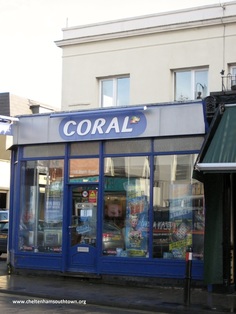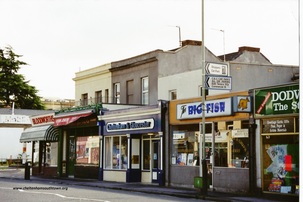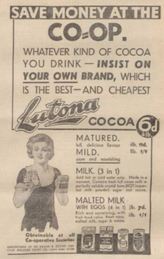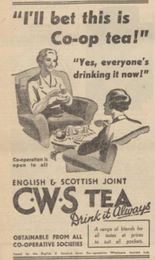Bath Road │16 previous / next │main map / bath road map
158 Bath Road (formerly 1 Clare Terrace)In 1832 the occupant of this house, Mr Thomas Gibbons, died and his furniture and other possessions were sold by public auction.
From 1888 this corner shop was the No 11 branch of the Gloucester Co-operative and Industrial Society, or ... the Co-op! In fact, the Co-op had several shops in this area over the years and this one in Bath Road was probably only second in importance to the main shop in the Strand. At a time when there were many grocery shops the Co-op’s advantage over the others was the ‘divi’ paid to its members. The system worked like this. Whenever a purchase was made, the receipt or ticket was saved. When one pounds worth had been collected, bundled up and tied with a strand of wool they were taken to the main office. Here, a cashier added up the bundles again and a members’ transfer check for the amount was issued to be paid into your account and entered in your pass book. Every six months a dividend was paid out in cash to members and long queues formed on paying out day. For many families the dividend made a real difference to their lives. The ‘divi’ handout continued well into the sixties.
 Gloucester Co-operative and Industrial Society Limited Gloucester Co-operative and Industrial Society Limited
The shop in Bath Road was much like any other grocer’s shop of the time. There were long brown wooden counters around all three sides of the shop with a large open space in the middle and a chair or two for the less sprightly customers. Scales on the counters weighed almost all dry goods – flour, biscuits, tea. Sugar was weighed and put into blue bags whilst salt was packed into cones of waxed paper to prevent them tearing. Behind the counter on one side of the shop was a wooden fixture with lots of drawers, which housed loose herbs and spices. On the opposite side of the shop was the provisions counter where cheese, bacon and other cold meats could be sliced as required. All purchases were made into a parcel with brown paper and tied with string with a loop for easy carrying. The counter facing the door was the bakery department. Bread and other groceries were delivered by horse and cart which had the slogan ’Each for All and All for Each’ written on the side.
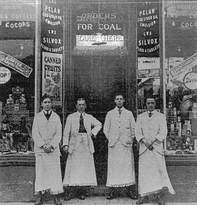 Co-op Staff c.1910 Co-op Staff c.1910
Washing soda was another commodity that was weighed and packed on the premises, usually in the back room. This job often fell to the corn boy, so called because another of his tasks was weighing and packing bran and corn for fowl. One of the Bath Road managers, Mr. Jack Large, started his long career with the Co-op as a corn boy at the age of fourteen in 1924. Then he worked at the Swindon Road branch getting to work with the aid of a pair of roller skates! From corn boy the men were promoted to Male Assistant, then First Hand followed by Assistant Manager and eventually to Manager. To be employed by the Co-op was a much sought after position and, providing that you behaved yourself, was a job for life with good pay including holiday and sick pay. On entering service with the Co-op you could join the union who would look after your interests.
There were many assistants in the shop, each able to add up in their heads the total of the customers shopping that they had served them with. No self-service or tills that added up for you in those days! The money in this particular shop was dispatched to the office across the ceiling in a vacuum-tube where the change would be put in and the tube sent back. One weekend in late May 1934 the shop was raided and more than 2000 cigarettes were stolen. The then manager, Mr Ernest Hopkins, opened the shop on the Monday morning to discover a hole in the roof of the warehouse at the rear of the shop and the cigarettes missing. The culprit was subsequently apprehended by the police in Bristol.
Mr. Large worked at several Co-ops in the town eventually becoming manager of this branch. When the Co-op moved further up the road to bigger premises in about 1940 he moved with them, retiring in 1975 after more than 50 years service. During the Second World War the Co-op’s premises, which they still owned, was used to billet some of the servicemen based in the town. After the War the building was again used by the Co-op until the late 1950s but was now a vegetable warehouse. For a short time in the early 1960s these premises became the Cheltenham branch of Harpers Garage. Harper’s dealt in second hand cars and had their main branch in Gloucester. In 1965 a very well established name came to Bath Road. The corn and seed merchant Bloodworth and Son closed their Albion Street shop and made the Bath Road their registered office.
The Bloodworth family came from Uley and the founder of the company, James, was born there about 1828. James started the business in Albion Street as the Cheltenham Machine and Hygienic Bakery at the end of the 1840s. The bakery was very large, employing only the best workmen, who used the most modern equipment and the highest quality ingredients thus making it one of the very best in the county. Many a local baker did their apprenticeships here including Dick Cripps from the bakery on the corner of Upper Bath Street. In addition to the bakery, Bloodworths did an extensive trade in hay, straw and animal feeds and this department was situated adjoining the bakery in Albion Street. Bloodworth’s supplied many local farmers with their animal feeds. Both businesses prospered and new branches were opened in Gloucester and Winchcombe although eventually the company concentrated on the corn merchants side of the business and the bakery closed. In the early 1960s Bloodworths established a mill in Leckhampton Road (near to the railway station) where they manufactured their animal feeds and soon after, they took over the shop at 158 Bath Road. During their stay of over thirty years, Bloodworths did a good trade as garden sundriesmen and established an excellent pet centre. Although the shop closed on January 17th 1998, Bloodworths still remains in the Bath Road, transferring the business to 180 Bath Road to join Newmans hardware store and become Bloodworth and Newman. After lying empty for over a year, in May 1999 it was leased by insurance brokers Bird Warwick Brown and in 2014 is a branch of Coral Bookmakers. Researcher: Marilyn West
Update: Stuart Manton (Jan 2017) |
The Old Town Survey map below shows how the shop fronts were built over the gardens.
|
If you have any further information or photographs of this property please let us know via the contacts page.
